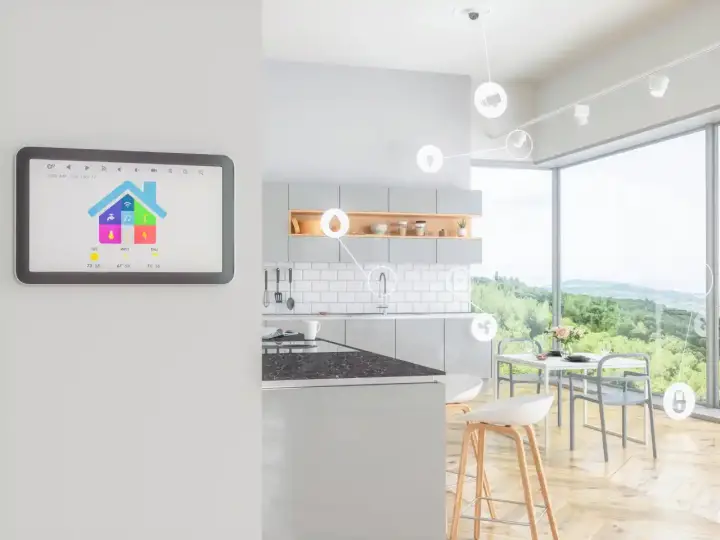Smart Home Gifting Guide: What To Buy And Why They Are Better
Updated on 24th May 2021 17:08 in General, Smart
Every time the holidays roll around, everyone turns to the good old tradition of giving. Indeed, receiving a gift can be one of the best feelings in the world, especially if it's from someone special. However, a common problem is deciding what to give when you aren't necessarily that familiar with their interests. If that happens to be anything smart home related, you are in the right place! Luckily, smart homes are actually a simple gift due to the large number of available products. Anything from voice assistants to smart plugs can be great gifts!

Disclaimer: This post contains affiliate links. As an Amazon Associate, I earn from qualifying purchases.
Table of Contents
Using GiftFinder To Make It Easy
This article is a great way to find a good gift for your friends, family, and loved ones, but there is a lot of information to take in before you will feel like you are making an informed decision. Instead of trying to learn it all, you might want to use our tool GiftFinder to answer a couple of questions and be on your way. In fact, the tool will ask you a selection of strategic questions to determine both your familiarity with the concepts and what your recipient will like. Once you reach the end, you will be presented with your results which will provide a short product description along with where you can buy it. GiftFinder takes all of the guessing out of buying a smart home gift for your loved one!
Check out GiftFinder on our tools page here!
Smart Home Gifting Guidelines
Before we get into the specifics of which product does what and why you might want to get it, we should first mention some rules to optimize the experience. A few products are actually quite a hot topic within the smart home community due to things like privacy and overall compatibility. I would strongly recommend avoiding any type of product that falls into one of these categories as the last thing you want is for the recipient of your thoughtful gift to be unable to use it. As a general rule, the following things are reasons your gift may fall short.
- Compatibility
- Privacy
- Amount Normally Used (how many do you need?)
All of the above can cause problems, but some are much more severe than others. As an example, the product not being compatible is much worse than whether it respects your privacy or not. We will briefly look at each factor in a bit more detail to better understand why we should keep them in mind while shopping.
Compatibility
One of the smart home industry's biggest problems is the insane state of the protocol landscape - just take a look at my Ultimate Guide to Smart Home Protocols to see just how many there are. To make a long story short, each manufacturer essentially has its own way of connecting its devices to each other. They rarely consider what's currently available and mostly ignore what other companies are using. They normally come out with their own version that isn't compatible with anything else. An example of this is the variation in smart switch networks to the point where some use proprietary networks that only work with the rest of your home via a bridge.
Bridges don't sound like the end of the world, but they can be expensive, prone to failure, and slower than connecting everything together directly. While the details are a story for another time, you will want to avoid these while gift shopping unless you know for sure that they already have the right bridge - or are willing to buy one. To visualize it a bit better, imagine buying smart lights that your recipient won't be able to use unless they go out and buy a special bridge!
Privacy
This one is important as it's commonly forgotten unless you are involved in the community. Everyone has a different idea of what privacy they expect in their home, which is why you should be extra careful with gifts that could violate it. Usually, this comes down to avoiding things with cameras in them or items sold by manufacturers that are notoriously bad at maintaining privacy. It's pretty difficult to determine with a good degree of certainty what someone's tolerance for this is, so if you aren't 100% sure, just make sure to keep the receipt!
Amount Normally Used
You might be wondering what on earth this category is supposed to be. The reality is that some smart devices are used in much larger quantities than others which may only have one. An example of a device used in large quantities is a smart plug, as you could technically use one for every electrical outlet in the house. On the other hand, you aren't normally going to need more than one smart hub for any given ecosystem. The same usually goes for voice assistants - most people don't want a second or third one once they get one.
Following the guidance of this category is simple, unless you know for sure that they need something for the "only need one" type, it's best to avoid them completely. Below is a partial list of products that are typically only needed once.
- Smart Hubs
- Voice Assistants
- Bridges (to go from one ecosystem to another)
- IR Blasters (Smart Remote Control)
This list is not exhaustive, but it should give you an idea of the type of thing you should probably avoid.
Suggestion Tags
To make things easier, each major device type will be tagged with a risk level indicating how likely it is that choosing an item from it will result in an unhappy recipient. This tag will consider all possible reasons and is meant to be a crude guide for someone who has never been involved with smart technology. Each section will be organized by price range, going from most expensive to most affordable. Finally, each will have a description explaining why you might want to get it along with the downsides if any.
Voice assistants
Price: 30$-400$
Risk score: High
These are perhaps the most iconic element of the modern smart home. It isn't hard to see how this could be the case, as the dream of being able to simply talk to your house to have it do things for you is clearly exciting for many. They are great for tying everything together and providing that extra level of integration you might be missing. The price varies immensely from one product to another because of the extreme difference in features between the cheapest and the most expensive product. In most cases, the cheapest will only have the absolute basics, such as a speaker and a microphone.
The audio quality of both will usually be terrible, making them only truly useful for controlling a smart home with your voice and for receiving acknowledgements. On the other end of the spectrum, expensive products come with features such as screens and premium speakers, which can easily act as the only sound source in a room. It's best to avoid the cheapest products to ensure you get a minimum standard of quality. Keep in mind most people only want one or maybe two of these! If they already have one, it might not be the best choice.
Echo Flex
The Echo Flex is the epitome of products designed only to serve their core function, as it really is about as basic as it gets. That's not to say that it doesn't offer some interesting features for the price! It includes a fully-featured Alexa voice assistant which can control compatible devices without any other hub. Keep in mind that it accomplishes this via the internet and not with a local control network, like the more expensive models. An interesting choice is that it has prongs for connecting it to an electrical outlet directly on the back. You can also purchase extensions separately that plug into the bottom of the device to serve as a night light, as an example.
Check out the Echo Flex on Amazon here!
Echo 4
The Echo 4 is perhaps the biggest change in design from one model to another, as the iconic hockey puck exterior has been replaced by a spherical shape. Unlike the Flex, it features a built-in Zigbee hub that can be used to control compatible products without using WiFi (or the internet). While local control can be a bit limited, the fact that it exists at all puts it ahead of the other Echo devices. It also includes a neodymium woofer and two 20mm tweeters for better audio quality than previously possible. In the case where you have multiple of them, they can play music together via multi-room audio to play music or anything else throughout your house.
Check out the Echo 4 on Amazon here!
Other options
I highly recommend the Apple HomePod Mini if the recipient has some Apple products (at minimum, an iPhone will be required for setup) as it offers excellent sound and is also a smart hub. HomeKit, which is the protocol HomePod uses, is excellent because of its local (offline) control and privacy advantages. You can also check out the other major player for voice assistants, Google, by looking at their Google Home product line. It shares many similarities with the Echo, though, so you are best to look elsewhere if you are looking for something entirely different.
Smart Thermostat
Price: 100$-200$
Risk: Moderate
These might be the best example of how quantity is important as most houses only have one thermostat. They can truly be amazing for adjusting the temperature based on any number of factors that are completely defined by the owner. Personally, I love the ability to make it hotter or colder without leaving my chair, but there is certainly an energy-saving aspect to them as well. Getting one of these as a gift presents a moderate risk because there can only really be one, but it's normally fairly easy to determine if they already have one before buying.
The other reason they may not be the best is that you can actually get rebates for certain models from your energy provider, depending on where you live. Great! Even better right? Not always - the rebate is usually on the energy bill, and sometimes there are only specific models that will be accepted. I would highly recommend making sure you don't interfere with this rebate program before going with a smart thermostat - I'm sure they will appreciate it! In terms of products, there are really only two main options.
Google Nest Thermostat
The Nest Thermostat is perhaps the most iconic because it was also one of the first products to advertise more eco-friendly features during a time of major concern over wasted energy. One such feature is that it can be programmed to use less energy while it isn't needed and to start up again when it is. However, this is more advanced than a simple timer as you can send it signals from your smart home when everyone is away! The design is rather slick and features a nice user interface that will send your old thermostat running for its money. The only real downside is that it relies heavily on WiFi and will basically stop being smart if the internet goes out. Another big concern is that not every furnace supports the "C" wire, which is required for some systems.
Check out the Google Nest Smart Thermostat on Amazon here!
Ecobee Lite Smart Thermostat
If the nest is commonly thought of as the original smart thermostat, the ecobee is a challenger seeking to become the preferred smart thermostat. For the most part, it can be more attractive than the Nest due to a set of amazing features even when compared directly. In fact, it has several features that make it unique such as native compatibility for most of the major ecosystems like HomeKit and SmartThings. That alone is enough to make the ecobee a better choice for those that use a supported protocol. Still, in addition, you also get the ability to integrate a SmartSensor directly. This adds extra value to the energy-saving features that you would otherwise need to add yourself.
Check out the ecobee Lite Smart Thermostat on Amazon here!
Smart Lights
Price: 10$-200$
Risk: Low
Smart lights are the bread and butter of smart home technology and have been since the beginning, thanks to their ability to create amazing visuals. Functionally, they only serve to light the way so that we can see where we are going, but practically, people place a lot of value in color changes, animations, and other such features. It's then no wonder that everything from smart bulbs to smart LED strips exists, and that's just the beginning! Why should you consider a smart light as a gift? There are a few reasons, such as the fact that you can use as many as you like, they are compatible with virtually all smart homes, and they look pretty awesome.
For a gift, I would recommend getting a smart bulb, a smart LED strip or something else that's easy to install. Smart switches are an option, of course, but they are typically much more complicated to install and present additional compatibility problems. If you are savvy, you could also offer to help install the gift if it's a bit more complicated - I'm sure they will appreciate that!
Meross Smart WiFi Bulb
Meross bulbs are always a good choice - they are well made and offer great compatibility with major smart hubs. They have tons of colors to choose from and can be dimmed via the app as well. They will fit in a standard E26 light socket, which tends to be the socket most commonly used for general lighting. You can even give the whole package by gifting both the bulb and the necessary parts to start - if you are shopping for an aspiring smart home owner. You can either use the Meross app, or you can integrate them directly into a HomeKit network.
Check out the Meross Smart WiFi Bulbs on Amazon here!
Meross Smart LED Strip
For some reason, finding a smart LED strip that's compatible with the ecosystem you are looking for is really difficult. Seriously, every time I go looking, I manage to find a ton of them that only work with the company's own app. Luckily, Meross has a model which uses WiFi to connect either to their app or to a HomeKit network. This direct connection to HomeKit makes it one of the only LED strips available that can directly be used with a hub without requiring an internet connection. Even if you don't use HomeKit, you can still use the Meross app to control settings such as color, brightness, and set timers to turn the lights on or off.
Check out the Meross Smart LED Strip on Amazon here!
Smart Plugs
Price: 10$-50$
Risk: Low
In much the same way that smart lights can be used in an almost infinite number of combinations, smart plugs can serve many different functions. You can use them to make regular appliances smart, like how I made a regular kettle smarter here. Anything you can think of that has only a basic level of built-in electronics can be controlled with a smart plug. These things include fans, coffee machines, kettles, space heaters, lamps, TVs, and tons more. It's important to remember that smart plugs are generally less useful than other types of smart technology on a case by case basis.
The difference appears when you consider the number of situations smart plugs can be used in while other devices would need to already be smart, which is often not the case. Some smart plugs offer energy monitoring in addition to the basic on/off. This can be useful to identify whether a device is currently on or off within your smart home. Additionally, you can also use this feature to monitor how much power a given appliance is consuming.
Meross Smart Plug
As with most other Meross products, these smart plugs feature native HomeKit integration in addition to the provided Meross app while also supporting the major ecosystems out of the box. These are incredibly cheap while still being well built - both extremely important factors when buying many of them. They are rated to handle up to 15 amps, which is usually the maximum a normal plug can supply anyways. In any case, that just means you need to be a bit careful not to plug something in that consumes too much power. The product is otherwise a good value that I recommend you use them anywhere you would get good value! I use one to control a small space heater.
Check out the Meross Smart Plug on Amazon here!
Kasa Smart Plug With Energy Monitoring
This smart plug includes something the other one doesn't - energy monitoring! It's important to realize that this comes at a hefty price. You can usually get a single one of these for the same price you would 3 of the previous kind. Sometimes, the extra monitoring really is worth it, though, such as when it can be used to detect if a kettle has finished boiling water. There are several ways this can be useful, so if you've ever thought that someone could make something they already own smarter, this is going to be a great gift! As with the other model, the current limit is 15 amps - so just be careful not to use more than that!
Check out the Kasa Smart Plug With Energy Monitoring on Amazon here!











